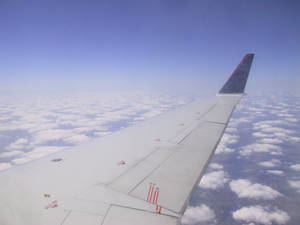An app to help jet lag
Interview with
If you've ever travelled across time zones, you know only too well how disabling it is when you arrive in that new time zone and you have to think and work or at least enjoy your holiday. But is there a better way to get over jet lag than just waiting 1 day per time zone to recover? Danny Forger who's a computational biologist at the University of Michigan spoke to Chris Smith about a new app called Entrain which he says will help.
is when you arrive in that new time zone and you have to think and work or at least enjoy your holiday. But is there a better way to get over jet lag than just waiting 1 day per time zone to recover? Danny Forger who's a computational biologist at the University of Michigan spoke to Chris Smith about a new app called Entrain which he says will help.
Chris - How does this work?
Danny - The app that we've just released, we used mathematics to calculate the quickest way to get an individual from one time zone to another. And so, the app puts this research in the hands of individuals.
Chris - First of all, tell us how does the maths mimic what's happening in a real body?
Danny - So, this is something that I've been working on for many years. In fact, I started working on this when I was an undergraduate at Harvard. There were a lot of experiments that were going on, testing human circadian rhythms. So, they would bring humans into a sleep lab and shine light on them and see how light affected their circadian clock. Light is the most important signal to your circadian clock. It's so important that in your eyes, there are actually specialised cells, separate from rods and cones that sense light, and send that information to your circadian clock. So there was a lot of data in particular, what was great about it was that it was human data where they gave individuals different pulses of light and what we did was we put this altogether into a mathematical model that we were able to show, was able to reproduce this data.
Chris - So, you've effectively built the human body clock in a computer.
Danny - Exactly. And how the model works is you give it a schedule and then it will say, "Well, at this particular time, you're not quite over your jet lag" or "At this time, you happen to be in Jakarta but your clock is back in Tokyo." What's significant about the paper that just came out in PLoS Computational Biology is that we were able to enter the reverse problem, rather than saying, "Here's a schedule and let's test it", we are able to say, "Of all possible schedules, which ones will get you from one time zone to the next in the quickest way possible?"
Chris - In other words, were I to depart from Heathrow today and head to Sydney and therefore, flip my body clock by, at the moment, about 9 hours, then what would I have to do when I get to Sydney to get myself feeling right and functioning best in the least possible time?
Danny - So let me start with what people thought you would have to do. We thought that the answer to this problem was going to be extremely complicated. Something along the lines of, at 4:00 o'clock, you would have to get 100 lux of light. At 4:45, you'd have to get 500 lux of light and that's really difficult, if not, impossible to do, except for certain very specialised people like Olympians for example or classical musicians. But the math actually came up with a very simple answer to this. Actually, it showed that that simple answer was better than anything else you could do. Basically, all you want to do is control when each day, you start getting light and when you start getting light, we'd suggest you get as much light as possible during that period and when you should stop getting light. So basically, just by controlling your dusk and dawn, you could get to the new time zone as quick as possible.
Chris - Does it work? That's the key thing.
Danny - Again, we know certain facts. We know that the model represents this human data very well and it's being used a lot and we know mathematically that these schedules are optimal. But again, I do think that we do need some more testing at this. In particular, all the work that's been proposed thus far is all based on laboratory studies. And what could be happening in the real world is quite different. Also, to test one individual schedule could cost hundreds of thousands of American dollars or British pounds and take years. And we have thousands of possible schedules if you think about all the possible permutations you could go through and all the possible light levels. So, that's part of the point of the app. The app is released for free. It gives you the access to the leading research. It actually simulates these models on the iPhone to predict where your circadian clock is and it also pulls out the optimal schedules to give you a suggestion of what to do. After doing this, you had the option of sending back your schedule and also, evaluating it anonymously to the University of Michigan. So, that's how we're going to test it. All I could say though is that this is the best answer we have right now.










Comments
Add a comment